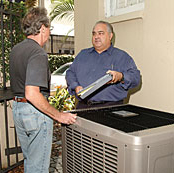
"We've put it this way: ‘Don't let a minimum efficiency standard be the maximum value you deliver to the customer,'" said Matt Petersen, vice president - sales and marketing, York Unitary Products Group (UPG).
"In other words, efficiency is important, but you cannot rely on efficiency to sell up and realize higher margins. We also need to sell comfort, including indoor air quality (IAQ), automated controls/zoning, acoustics, and even aesthetics - which can help the customer understand and appreciate the step up to higher efficiency.
"These can be important differentiators for the contractor at the retail level and should be part of the customer conversation before a price proposal is offered."
According to Petersen, after 13 SEER becomes the minimum efficiency standard next year, it's either sell or go away.
"Kind of harsh?" asked Petersen, before answering his own question. "But, it's reality. We all know residential HVAC changes forever next year. And, changes are scary. But they can be good, because the 13 SEER standard can actually improve profitability - if we think retail and focus on merchandising and selling, instead of quoting and installing."
As industry insiders are quick to point out, 13 SEER is where efficiency starts in 2006, not where it ends. So, if a contractor does not sell up, most sales will be in the least profitable, low-end segment of the market.
"If contractors attempt to sell strictly along the lines of higher efficiency in a post-13 SEER market, they will experience difficulties convincing customers to buy up," commented Drew Fitzgerald, vice president of marketing, residential and light commercial, Nordyne.
"Today's consumers are requesting improvements to their home comfort systems like better efficiency, more even room temperature, better air purification, better temperature control, improved airflow, reduced noise, better humidity control, and faster heating and cooling."

Ask Questions
Given this trend, if contractors want to successfully sell indoor comfort, they must address these concerns by asking customers about their indoor comfort needs. If contractors are not asking questions now in order to help solve a homeowner's indoor comfort needs, they should be doing so in the near future, said Fitzgerald.Sample questions related to indoor comfort include:
"Selling comfort to homeowners isn't as simple as presenting a list of products," cautioned Robin Pharo, channel manager-residential products, Aprilaire. "In order to get customers interested in upgrading, they need to feel that you know what is important to them and that you can provide so much value that any product they choose will pay for itself in comfort, improved health, and energy savings within their home."
Pharo pointed to humidity control. When customers do not have a true humidity control system in the winter, they often end up setting their thermostat higher in order to feel warm. They can also struggle with upper respiratory infections, static shock, and other problems. Many homeowners do not know that contractors can solve these issues.
"However, we have found in our research that consumers are not aware of many products that are available for them to improve their home environment," said Pharo. "In fact, in some cases, they don't even know that they have a problem. They do not know there are products out there that can help.
"And if you just list a product name on a quote sheet, dealers are missing out on the opportunity to explain the ‘why' of the product. Why do they need it? Why is it important? Why can't I live without it?"
In Pharo's estimation, if contractors approach customers thinking about the "why" instead of the "what," they will quickly see what products are essential in homes.
"Take dehumidification," she said. "Air conditioning does provide dehumidification, but it isn't set up to truly control dehumidification. But when a dealer talks about true humidity control in the summer, he can explain how it allows people to feel more comfortable at a higher thermostat temperature. It also reduces the risk of mold growth and dust mites. It eliminates the damp, sticky environment that happens when there is no air conditioning loads.
"All of a sudden, when the dealer tells them why they need humidity control, their customers are asking, ‘How?' How can they get this benefit? When can they get this benefit? They are selling themselves on the product and the dealer becomes the solution provider, not a product seller."
Raymond Granderson, supervisor of training, products and services, Rheem Air Conditioning Division, put it this way: "Remember that a feature is a product, but a benefit is a reason for using it. We are in an era where benefits can help us. We need to sell them on benefits - what the product can provide for the homeowner."

Onward And Upward
In the end, good, better, best selling may continue to be the sales approach in 2006 and beyond, but it certainly won't mean simply offering a range of SEER ratings."It will mean a professional presentation to homeowners, selling beyond efficiency," said Peterson.
"That means changing homeowners' perception of HVAC to a value-added, aesthetic part of the home - not a box that heats, cools, is replaced when it fails, and needs bushes around it.
"In other words, it's time to sell premium products' appeal, your reputation, customer relationships, and the expert installation and service you provide."
It is Granderson's belief that many contractors just have not taken the time to educate themselves on accessories. As a result, they are not being offered to the homeowner. Now is the time to learn, he said, especially with 13 SEER just around the corner.
"There is an education process in order to sell whole-house comfort," said Granderson. "Therefore, contractors need to educate themselves on what these accessories are all about. You need to learn everything you can. You must not be afraid of change."
Publication date: 06/27/2005

Report Abusive Comment